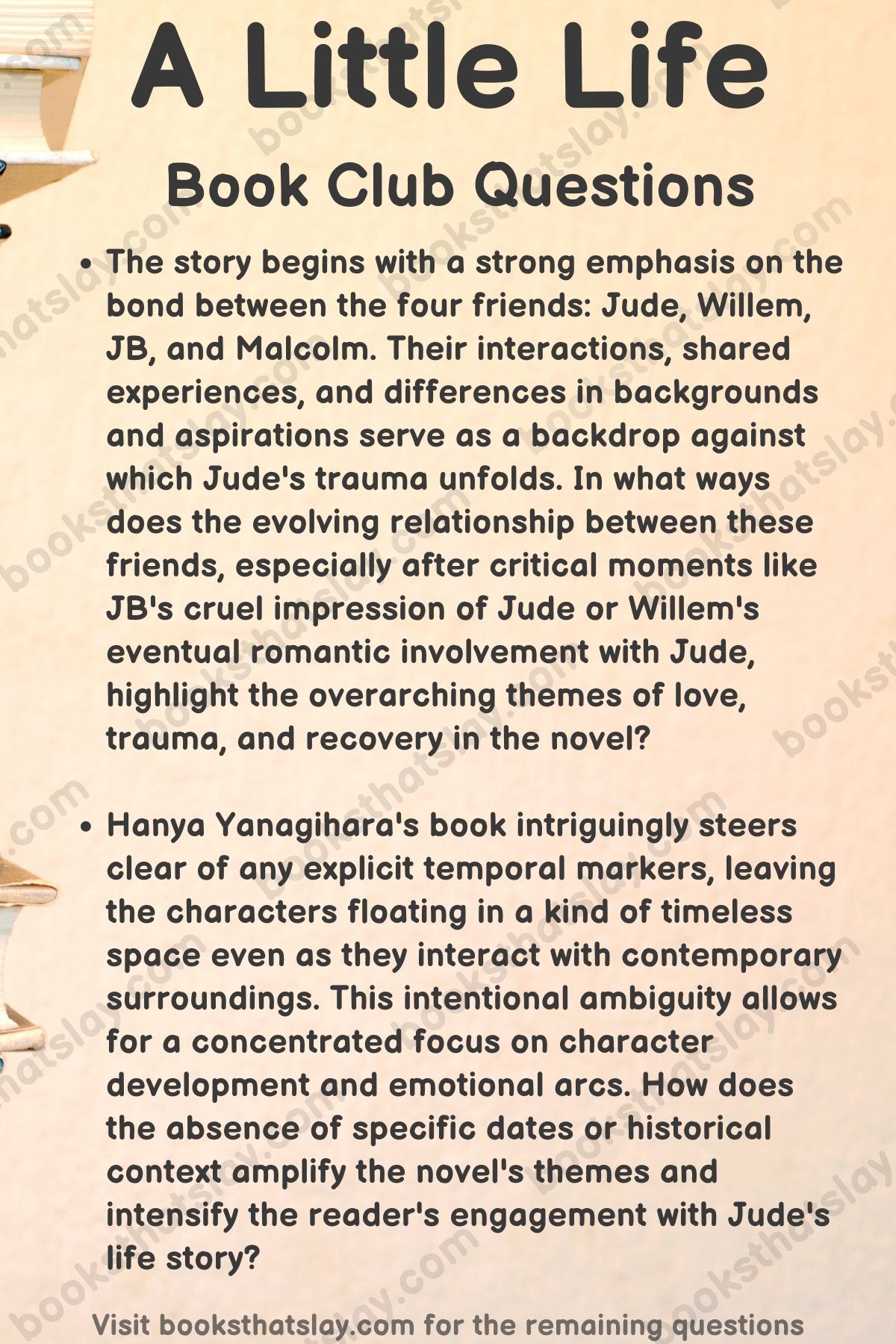20 A Little Life Book Club Questions For Discussion
“A Little Life” is a tough read for sure, but it’s also incredibly moving and thought-provoking.
If you’re looking to talk about the book with others who’ve read it, a book club gathering in such a case is perfect! You can analyze the characters, discuss the big themes, and even talk about how the book affected you personally.
Hence, in order to make your discussions much more fruitful, here is a list of some amazing book club questions for A Little Life by Hanya Yanagihara.

A Little Life Book Club Questions
- Hanya Yanagihara deliberately obscures details of Jude’s past – his history, sexuality, and even his race. How does this strategic ambiguity shape our understanding of Jude’s character, specifically the way his overwhelming trauma erodes his capacity for a defined sense of self?
- The friendships between Jude, Willem, JB, and Malcolm form a core element of the novel. How do these relationships transform in the face of Jude’s trauma, and how do critical moments (like JB’s cruel impression and Willem’s evolving romantic feelings) illuminate the complex intersection of love, trauma, and the challenges inherent within support systems?
- Jude’s life is marked by recurring patterns of abuse. Analyze the parallels and dissonances between his past abusers (such as Brother Luke) and the damaging figures in his present (like Caleb). How does this exploration of cyclical abuse deepen our understanding of the lasting psychological and emotional scars left by Jude’s traumatic experiences?
- Yanagihara subverts conventional expectations of healing by depicting Jude’s trauma as an enduring struggle. Do you believe she effectively conveys her intended message about the potential permanence of certain traumas? How does this challenge conventional literary tropes surrounding recovery and healing?
- The novel intentionally avoids specific temporal markers, creating a sense of timelessness. How does this choice contribute to a more concentrated focus on Jude’s internal journey and emotional experiences? Does it amplify the novel’s themes and create a more deeply affecting reading experience?
- New York City’s allure and competitiveness form a stark backdrop to Jude’s personal struggles. How does the city itself function as a character, both highlighting Jude’s past trauma and shaping his (and his friends’) ambitions and experiences?
- Jude’s physical pain serves as a constant manifestation of his past. How does this mirroring of physical and psychological trauma shape his sense of self? In what ways does it hinder or influence his relationships?
- Harold and Julia’s unwavering love for Jude challenges traditional ideas of parenthood, especially amidst his complex struggles. How does Yanagihara use their relationship to explore unique facets of adoptive parenthood and redefine our understanding of familial bonds?
- Jude’s deep-rooted struggles with self-worth stem directly from his trauma. How does this internal battle shape his behaviors, relationships, and reluctance to heal? Does Yanagihara’s portrayal highlight the impact of societal stigma and expectations placed on trauma survivors?
- Jude achieves remarkable success as a litigator, his professional life seemingly untouched by his profound personal struggles. How does his professional persona contrast with his inner turmoil? Does his career offer a form of control or even a distraction from the emotional pain he carries?
- The novel explores various forms of art: Willem’s acting, JB’s painting, and even Jude’s mathematical work. How do these artistic expressions function for the characters? Do they offer moments of healing, a means of processing trauma, or can they potentially exacerbate existing pain?
- Willem, Harold, Ana, and others provide extensive care for Jude throughout the novel. Yet, there’s an underlying tension between their well-intentioned support and Jude’s profound need for autonomy. Does the novel raise questions about the limits of caregiving, and how to balance respecting a trauma survivor’s agency with the desire to help?
- Jude’s meticulous self-care routines and attempts to exert control over his life seem like protective strategies against the chaos of his past. How does this need for control manifest in his relationships and choices? Does it ultimately help or hinder his journey?
- Religious figures and imagery feature in Jude’s past and present. How does Yanagihara portray religion? Is it a source of potential healing, a reminder of trauma, or something else entirely?
- Jude’s friendships defy traditional categorization. They encompass immense love, complicated dynamics, and moments of both connection and painful misunderstanding. How does Yanagihara challenge conventional definitions of friendship, especially within the context of trauma and caregiving?
- Jude remains fiercely protective of his past, unwilling to disclose his history even to his closest confidantes. How does the weight of these secrets affect Jude and his loved ones? Does the novel suggest the necessity of disclosure for healing, or does it offer a more nuanced view?
- “A Little Life” offers no easy resolutions. How do you interpret the novel’s ending? Is there a sense of closure, acceptance, or something else entirely? Does the ambiguity enhance or detract from the novel’s power?
- Jude’s physical limitations and chronic pain are a constant presence in his life. How does Yanagihara portray disability? Does the novel challenge or reinforce stereotypes about disabled individuals?
- Despite Jude’s traumas, he also experiences significant privilege in areas such as his career and financial stability. How does the intersection of privilege and profound vulnerability shape Jude’s experiences and our understanding of his character?
- While Jude’s friends are deeply devoted to him, they often struggle to fully comprehend the depths of his suffering. How does the novel explore the limits of empathy, even within the context of loving relationships?
Read our discussion questions for other books